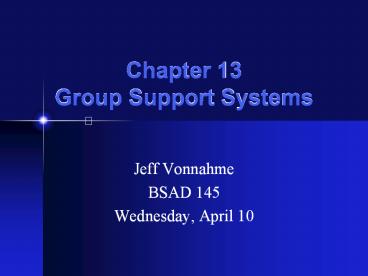Chapter 13 Group Support Systems - PowerPoint PPT Presentation
Title:
Chapter 13 Group Support Systems
Description:
Chapter 13 Group Support Systems Jeff Vonnahme BSAD 145 Wednesday, April 10 Outline Why are Group Systems Important Types of Group Support Systems Groupware on the ... – PowerPoint PPT presentation
Number of Views:17
Avg rating:3.0/5.0
Title: Chapter 13 Group Support Systems
1
Chapter 13Group Support Systems
- Jeff Vonnahme
- BSAD 145
- Wednesday, April 10
2
Outline
- Why are Group Systems Important
- Types of Group Support Systems
- Groupware on the Internet
- Group Decision Support Systems (GDSS) systems
that support decision making by more than one
person, working together to reach a decision
3
Why are Group SystemsImportant?
- Teams may be the basis for future organizations
- Peter Drucker organizations are becoming
information basedfuture organizations will be
composed of specialists who direct their
performance through feedback from others - Coordination theory may guide organizational
design - Malone (MIT) lessons learned about how large
groups coordinate work can be applied to
coordinating large groups of computing resources - Companies want to manage knowledge
- Attempts to capture knowledge (explicit vs.
tacit) - The Rudy Problem
4
Types of Group Support Systems
- Supporting Same Time/Same Place Groups
- Problems with meetings
- IT can help improve meetings
- Supporting Presentations and Discussions
- Davidson and Briggs Use of GSS in a
presentation-discussion session held in a
workshop setting - Supporting Dispersed Groups
- Ongoing coordination by groups working at
different times and places - Johansens Matrix
5
Groupware on the Internet
- Major uses for web-based groupware
- To support project team activities
- To support education
- To replace email listserv systems
- (Wheeler, Dennis, Press)
- Advantages Disadvantages
6
CLJ
- Cio.com Real-Time Collaboration Tools
- http//www.cio.com/archive/040197/et.html
- This article looks at the increasing need for
immediate collaboration of several people when
making important business decisions. The answer
for these needs? Group decision support systems.
The author lists new technologies such as
convergence of data, audio conferencing and
videoconferencing as the gateway for the bringing
together of far-away employees in real-time
setting. While some big companies are focusing
on GDSSs, many are adopting groupware
applications. The most common today is
Microsofts NetMeeting, which allows users to
share applications and communicate in real-time
conferences. Other companies such as 3M are
restructuring their processes to promote
interoperability. Technology like PictureTalk
helps to bridge different applications among
users, allowing different programs to
communicate. Many companies are restructuring
their networks to support these new technologies.
DataBeam has developed a system that works with
the business network to tie employees through web
server and browser technology. Finally, new
products such as Cybercasting will be the wave of
the future. This application looks to erase the
technical limitations of audio and
videoconferencing. Whatever technology companies
choose to implement, it should be noted that
applications providing compatibility across PC
vendors should be a top priority. - "Instead of having people travel for a two- or a
three-week course, all you really want to do is
get people together to talk. It's not the same as
a face-to-face experience, but it's rich and
interesting in its own way." - Ellen Isaacs
(Electric Communities)
7
CTQ
- Supporting dispersed groups is one of the most
promising uses for ongoing coordination by groups
who work at different times and different places.
This technology can be used to stretch the
workday to round-the-clock by passing work from
groups in one region to the next at the end of
each ones workday. page 410 - Would passing work from one employee to another
have a negative effect on the work being
conducted? If so, how? - Should large international companies restructure
their networks to support a 24 hour
cross-regional workday? - Will these practices become the standard in the
future due to the fact that companies can finish
projects in half the time? - Should companies consider creating branches in
Europe and Asia to enable this competitive edge?
- Would these practices be particularly difficult
to manage?
8
- Any Questions?
- Thank You!!































